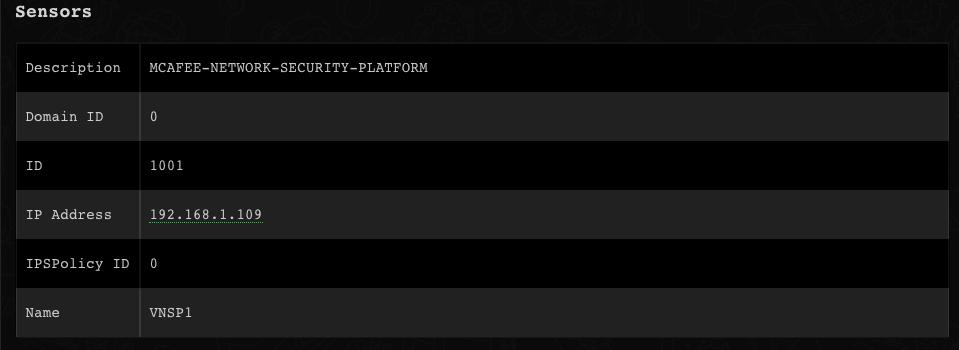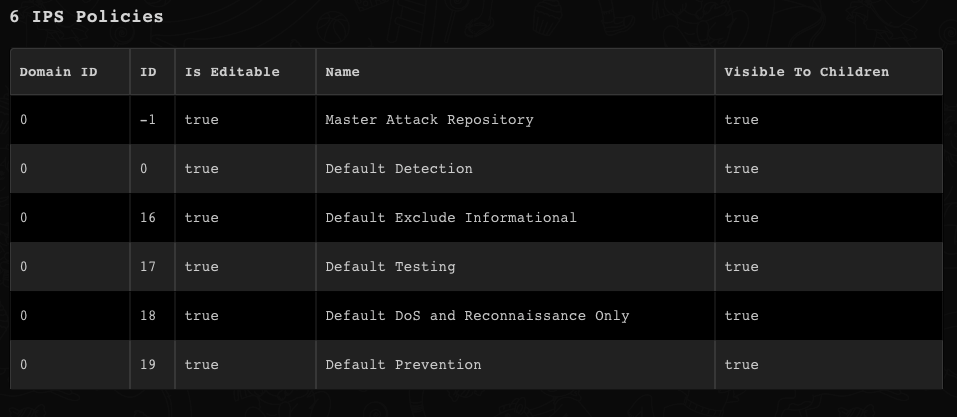Overview
Use the McAfee NSM integration in Cortex XSOAR to retrieve information about sensors, domains, policies, alerts, and attacks in McAfee NSM.
This integration was integrated and tested with McAfee v9.1.
Configure McAfee NSM on Cortex XSOAR
-
Navigate to
Settings
>
Integrations
>
Servers & Services
.
-
Search for McAfee NSM.
-
Click
Add instance
to create and configure a new integration instance.
-
Name
: a textual name for the integration instance.
-
URL (for example:
https://192.168.0.1:5000
)
-
Username
-
Use system proxy settings
-
Trust any certificate (not secure)
-
Click
Test
to validate the URLs, token, and connection.
Commands
You can execute these commands from the Cortex XSOAR CLI, as part of an automation, or in a playbook. After you successfully execute a command, a DBot message appears in the War Room with the command details.
-
Get a list of sensors for a domain: nsm-get-sensors
-
Get all domains: nsm-get-domains
-
Get alerts: nsm-get-alerts
-
Update alert information: nsm-update-alerts
-
Get details for a single alert: nsm-get-alert-details
-
Get IPS policies in a domain: nsm-get-ips-policies
-
Get policy details for a single IPS policy: nsm-get-ips-policy-details
-
Get all attack definitions: nsm-get-attacks
1. Get a list of sensors for a domain
Returns a list of sensors for a specified domain.
Base Command
nsm-get-sensors
Input
|
Argument Name
|
Description
|
Required
|
|
domainID
|
The domain of the sensors. If blank, returns all sensors.
|
Optional
|
Context Output
|
Path
|
Type
|
Description
|
|
NSM.Sensors.ID
|
string
|
Sensor ID
|
|
NSM.Sensors.Description
|
string
|
Sensor description
|
|
NSM.Sensors.DomainID
|
string
|
Sensor's domain ID
|
Command Example
!nsm-get-sensors domainID=0
Context Example
{
"NSM": {
"Sensors": {
"Description": "MCAFEE-NETWORK-SECURITY-PLATFORM",
"DomainID": 0,
"ID": 1001,
"IP Address": "192.168.1.109",
"IPSPolicyID": 0,
"Name": "VNSP1"
}
}
}
Human Readable Output

2. Get all domains
Returns all domains.
Base Command
nsm-get-domains
Input
|
Argument Name
|
Description
|
Required
|
|
domain
|
Specific domain details. If blank, returns all domains.
|
Optional
|
Context Output
|
Path
|
Type
|
Description
|
|
NSM.Domains.ID
|
number
|
Domain ID
|
|
NSM.Domains.Name
|
string
|
Domain name
|
Command Example
!nsm-get-domains domain=0
Context Example
{
"NSM": {
"Domains": {
"ID": 0,
"Name": "My Company"
}
}
}
Human Readable Output

3. Get alerts
Returns alerts according to query parameters.
Base Command
nsm-get-alerts
Input
|
Argument Name
|
Description
|
Required
|
|
time_period
|
Time period
|
Optional
|
|
start_time
|
Start time in "mm/dd/yyyy HH:MM" format only. Used for custom time only.
|
Optional
|
|
end_time
|
End time in "mm/dd/yyyy HH:MM" format only. used for custom time only
|
Optional
|
|
state
|
Alert state
|
Optional
|
|
search
|
Search string in alert details
|
Optional
|
|
filter
|
Filter alert by fields. Example: "name:hello;direction:Inbound,Outbound;attackcount:>3,<4".
|
Optional
|
Context Output
|
Path
|
Type
|
Description
|
|
NSM.Alerts.ID
|
number
|
Alert ID
|
|
NSM.Alerts.Name
|
string
|
Alert name
|
|
NSM.Alerts.State
|
string
|
Alert state (
Acknowledged
,
Unacknowledged
)
|
|
NSM.Alerts.CreatedTime
|
string
|
Alert creation time
|
|
NSM.Alerts.Assignee
|
string
|
Alert assignee
|
|
NSM.Alerts.AttackSeverity
|
string
|
Alert severity
|
|
NSM.Alerts.Application
|
string
|
The application associated with the alert
|
|
NSM.Alerts.EventResult
|
unknown
|
Event result
|
|
NSM.Alerts.Event
|
unknown
|
The event that triggered the alert
|
|
NSM.Alerts.Attack
|
unknown
|
Alert's attack
|
|
NSM.Alerts.Attacker
|
unknown
|
The attacker who committed the attack
|
|
NSM.Alerts.Target
|
unknown
|
The attack's target
|
|
NSM.Alerts.MalwareFile
|
unknown
|
Malware file used in the attack
|
Command Example
!nsm-get-alerts state=ANY
4. Update alert information
Update the state or the assignee of specified alerts.
Base Command
nsm-update-alerts
Input
|
Argument Name
|
Description
|
Required
|
|
state
|
Alert state
|
Optional
|
|
time_period
|
Time period
|
Optional
|
|
start_time
|
Start time in "mm/dd/yyyy HH:MM" format only. Used for custom time only
|
Optional
|
|
end_time
|
End time in "mm/dd/yyyy HH:MM" format only. Used for custom time only
|
Optional
|
|
new_state
|
The new alert state
|
Optional
|
|
new_assignee
|
The new assignee
|
Optional
|
|
search
|
Search string in alert details
|
Optional
|
|
filter
|
Filter alert by fields. Example: "name:hello;direction:Inbound,Outbound;attackcount:>3,<4"
|
Optional
|
Context Output
|
Path
|
Type
|
Description
|
|
NSM.Alerts.ID
|
number
|
Alert ID
|
|
NSM.Alerts.Name
|
string
|
Alert name
|
|
NSM.Alerts.State
|
string
|
Alert state (
Acknowledged
,
Unacknowledged
)
|
|
NSM.Alerts.CreatedTime
|
string
|
Alert creation time
|
|
NSM.Alerts.Assignee
|
string
|
Alert assignee
|
|
NSM.Alerts.AttackSeverity
|
string
|
Alert severity
|
|
NSM.Alerts.Application
|
string
|
The application associated with the alert
|
|
NSM.Alerts.EventResult
|
unknown
|
Event result
|
|
NSM.Alerts.Event
|
unknown
|
The event that triggered the alert
|
|
NSM.Alerts.Attack
|
unknown
|
Alert's attack
|
|
NSM.Alerts.Attacker
|
unknown
|
The attacker who committed the attack
|
|
NSM.Alerts.Target
|
unknown
|
The attack's Target
|
|
NSM.Alerts.MalwareFile
|
unknown
|
Malware file used in the attack
|
Command Example
!nsm-update-alerts start_time="10/10/2018 08:00" state=Acknowledged
5. Get details for a single alert
Returns details for a single, specified alert.
Base Command
nsm-get-alert-details
Input
|
Argument Name
|
Description
|
Required
|
|
alert_id
|
Alert ID
|
Required
|
|
sensor_id
|
Sensor ID
|
Required
|
Context Output
|
Path
|
Type
|
Description
|
|
NSM.Alerts.ID
|
string
|
Alert ID
|
|
NSM.Alerts.Name
|
string
|
Alert name
|
|
NSM.Alerts.State
|
string
|
Alert state (
Acknowledged
,
Unacknowledged
)
|
|
NSM.Alerts.CreatedTime
|
date
|
Alert creation time
|
|
NSM.Alerts.Assignee
|
string
|
Alert assignee
|
|
NSM.Alerts.Description
|
string
|
Alert description
|
|
NSM.Alerts.EventResult
|
string
|
Event result
|
|
NSM.Alerts.Event
|
unknown
|
Alert event
|
|
NSM.Alerts.Attack
|
unknown
|
Alert's attack
|
|
NSM.Alerts.Attacker
|
unknown
|
The attacker who committed the attack
|
|
NSM.Alerts.Target
|
unknown
|
The attack's target
|
|
NSM.Alerts.MalwareFile
|
string
|
Malware file used in the attack
|
|
NSM.Alerts.Details
|
unknown
|
Extra details
|
Command Example
!nsm-get-alert-details alert_id=0
6. Get IPS policies in a domain
Returns the IPS policies in a domain.
Base Command
nsm-get-ips-policies
Input
|
Argument Name
|
Description
|
Required
|
|
domain_id
|
Domain ID
|
Required
|
Context Output
|
Path
|
Type
|
Description
|
|
NSM.IPSPolicies.ID
|
number
|
IPS policy ID
|
|
NSM.IPSPolicies.Name
|
string
|
IPS policy name
|
|
NSM.IPSPolicies.DomainID
|
number
|
IPS policy domain ID
|
|
NSM.IPSPolicies.IsEditable
|
boolean
|
Whether you can edit the IPS policy
|
|
NSM.IPSPolicies.VisibleToChildren
|
boolean
|
Whether the IPS Policy is visible to domain's children
|
Command Example
!nsm-get-ips-policies domain_id=0
Context Example
{
"NSM": {
"IPSPolicies": [
{
"DomainID": 0,
"ID": -1,
"IsEditable": true,
"Name": "Master Attack Repository",
"VisibleToChildren": true
},
{
"DomainID": 0,
"ID": 0,
"IsEditable": true,
"Name": "Default Detection",
"VisibleToChildren": true
},
{
"DomainID": 0,
"ID": 16,
"IsEditable": true,
"Name": "Default Exclude Informational",
"VisibleToChildren": true
},
{
"DomainID": 0,
"ID": 17,
"IsEditable": true,
"Name": "Default Testing",
"VisibleToChildren": true
},
{
"DomainID": 0,
"ID": 18,
"IsEditable": true,
"Name": "Default DoS and Reconnaissance Only",
"VisibleToChildren": true
},
{
"DomainID": 0,
"ID": 19,
"IsEditable": true,
"Name": "Default Prevention",
"VisibleToChildren": true
}
]
}
}
Human Readable Output

7. Get policy details for a single IPS policy
Returns policy details for the specified IPS policy.
Base Command
nsm-get-ips-policy-details
Input
|
Argument Name
|
Description
|
Required
|
|
policy_id
|
IPS Policy ID
|
Required
|
Context Output
|
Path
|
Type
|
Description
|
|
NSM.IPSPolicies.ID
|
number
|
IPS policy ID
|
|
NSM.IPSPolicies.Name
|
string
|
IPS policy Name
|
|
NSM.IPSPolicies.Description
|
string
|
IPS policy information
|
|
NSM.IPSPolicies.CreatedTime
|
string
|
Policy creation time
|
|
NSM.IPSPolicies.IsEditable
|
boolean
|
Whether you can edit the IPS policy
|
|
NSM.IPSPolicies.VisibleToChildren
|
boolean
|
Whether the IPS Policy is visible to domain's children
|
|
NSM.IPSPolicies.Version
|
number
|
IPS policy version
|
|
NSM.IPSPolicies.InboundRuleSet
|
unknown
|
Inbound rule set
|
|
NSM.IPSPolicies.OutboundRuleSet
|
unknown
|
Outbound rule set
|
|
NSM.IPSPolicies.ExploitAttacks
|
unknown
|
A list of exploit attacks related to the IPS Policy
|
Command Example
!nsm-get-ips-policy-details policy_id=0
Human Readable Output

8. Get all attack definitions
Returns all available attack definitions in McAfee NSM.
Base Command
nsm-get-attacks
Input
|
Argument Name
|
Description
|
Required
|
|
attack_id
|
Particular attack ID
|
Optional
|
Context Output
|
Path
|
Type
|
Description
|
|
NSM.Attacks.ID
|
string
|
Attack ID
|
|
NSM.Attacks.Name
|
string
|
Attack name
|
|
NSM.Attacks.Severity
|
number
|
Attack severity
|
|
NSM.Attacks.Direction
|
string
|
Attack direction
|
|
NSM.Attacks.Category
|
string
|
Attack category
|
Command Example
!nsm-get-attacks attack_id="0x00000100"
Context Example
{
"NSM": {
"Attacks": {
"Category": "EXPLOIT",
"Direction": null,
"ID": "0x00000100",
"Name": "IP: IP Fragment too Large",
"Severity": 5
}
}
}
Human Readable Output

Troubleshooting
If you receive an
401 Unauthorized
error, the user credentials may be incorrect.




